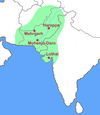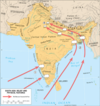Unit 4 (Ancient India) Flashcards
(91 cards)
Aryans
A group of nomadic people of Eurasian ancestry who invaded civilizations in the Indus River Valley around
1500 BCE and combined their own cultures and traditions with those of the people living there.

Caste System
The social class system that divided ancient India’s social groups (Brahman at the top, then Kshatryia, then Vaisha, then Shudra at the bottom).

Citadel
A structure built for citizens to go for safety in the case of an attack

Empire
A political unit or large geographic area that is ruled under a unified authority such as an emperor or king

Ganges River
A river in India rising in the Himalayas and flowing generally east to the Bay of Bengal

Harrapa
An ancient city whose remains have been found in the Indus River Valley; lasted about 2500-1500 BCE

Himilayas
Mountain range in Asia, extending east through Pakistan, India, China, Nepal, and Bhutan

Hinduism
The oldest and most widely practiced religion and cultural tradition in India

Indian Subcontinent
A geographic region that makes up most of South Asia and is separated from the rest of Asia
by mountains and ocean; includes countries of Pakistan, India, Bhutan, Nepal, Bangladesh, and Sri Lanka

Indus River
A river in south-central Asia beginning in southwest Xizang (Tibet) and flowing northwest through
northern India and southwest through Pakistan to the Arabian Sea

Mohenjo-Daro
An ancient city whose remains have been found in Indus River Valley; lasted about 3000-1500 BCE

Monsoon
A seasonal, intense wind in Asia that blows from the southwest from June to September, creating heavy
rainstorms and from the northeast from October to May, creating dry weather

Reincarnation
A belief in the Hindu religion that the soul reappears after death in another and different bodily form

Surplus
An excess of something, or an amount remaining once the demand for the item has been met

Vedas
Four ancient sacred books of Hinduism, consisting of hymns, chants, and sacred formulas

Label the Indian Map

- Indian Subcontinent
- Himilayan Mountain Range
- Mount Everest
- Indus River
- Arabian Sea
- Ganges River
- Bay of Bengal
- Brahmaputra River
- Deccan Plateu
- Indian Ocean
- Sri Lanka
What is the name of the landform most of India lies on?
The Indian Subcontinent
How were the Himilayan Mountains created?
The Himilayan Mountains were created by the collision of the Indian Subcontinent & the Eurasian plate.
How tall is Mount Everest?
It is the tallest mountain in the world, approximately 29,029 ft tall (almost 6 miles).
Where do the rivers of India get most of their waters from?
The Himilayan Mountain Range
The Indus River is located in which modern-day country?
Pakistan
What is the most populated river in the world? How many people live there?
The Ganges River is the most populated river in the world. And approximately 400 million people live along that river.
The Brahmaputra River & the Ganges river combine and form a large delta in what country?
The 2 rivers create a river delta that is very fertile, in Bangladesh
What is a Plateau? What is the name of the plateau located in southern India?
A plateau is a large area of mostly flat level land. And the plateau in southern India is called the Deccan Plateau.



















